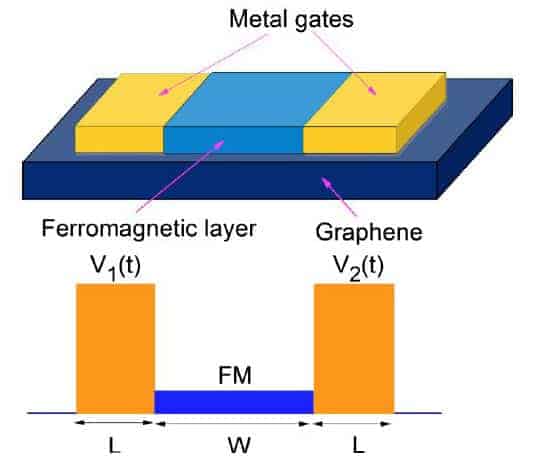
Physicists in China say that they have made an important advance towards developing spintronics devices made from graphene by generating a pure spin current in the material – something that has proven very difficult to do. Spintronics is a relatively new technology that exploits the spin of an electron as well as its charge and promises smaller and more efficient electronic circuits than those available today.
The spin of an electron can point in an “up” or “down” direction, and this property could be used to store and process information in spintronics devices. Such circuits would be smaller and more efficient than conventional electronic circuits – which rely on switching charge alone – because switching spins from up to down can be done using very little energy.
Graphene is a sheet of carbon just one atom thick that could be important for spintronics because electron spins in the material can maintain their direction for a long time, says team leader Kwok Sum Chan of the City University of Hong Kong. This means that stored information wouldn’t easily be lost.
Small spin-orbit interaction
Spintronics devices would carry or manipulate information via a pure spin current, which consists of electrons with opposite spins moving in opposite directions. However, it is difficult to generate a pure spin current in graphene because the material has a very small spin-orbit interaction. Normally, it is easy to generate pure spin current in semiconductors that have strong spin-orbit interactions through the spin Hall effect.
Chan and colleagues Zijing Lin of the University of Science and Technology of China and Qingtian Zhang at the CityU-USTC have now proposed a way to generate pure spin current in graphene as well as spin-polarized current. Spin-polarized current is a charge current with an uneven distribution of electron spin directions – that is, different numbers of up spin and down spin electrons.
“Our method is an important development because it does not require an external magnetic field – unlike other techniques to produce pure spin current,” Chan told physicsworld.com.
Controlling the polarization
The method employs ferromagnetic thin films deposited on graphene and two metal electrodes, and so could be used to make nanometre-sized spintronics devices. The degree of polarization of the current can also be easily changed by changing the Fermi energy. “For example, you can obtain a spin current consisting of electrons with up spin only or a spin current containing down spin only,” explained Chan. Being able to control the degree of polarization in this way is important for developing future spintronics devices.
Chan and colleagues exploited two physical phenomena in their technique: the ferromagnetic proximity effect and “adiabatic quantum pumping”. Through the ferromagnetic proximity effect, electrons with different spins have different energies when they are under, and interact with, the ferromagnetic layer deposited on graphene. This means that electrons with differently oriented spins move differently under adiabatic pumping.
In adiabatic pumping, a DC electrical current is generated by two AC electrical potentials in the system and does not need a DC applied voltage. Normally, DC electric current is generated by DC voltage differences. The technique is routinely used in semiconductors to generate spin currents, but never in graphene before now.
Future applications
According to the team, future applications could include graphene quantum computers because the spin current might be used to generate spin polarization in graphene quantum dots for use as quantum bits. Spin current could also be used to control, rotate and detect spins in such qubits.
Another application would involve using the spin current to rotate magnetization in a ferromagnetic nanostructure, which might have applications in magnetic storage such as magnetic random access memory.
The researchers say that they now plan to develop a technique to detect spin current in graphene. Unlike charge current, spin current is difficult to detect.
The work was published in Appl. Phys. Lett. 98 032106.



